数学分析第一章
- 格式:pdf
- 大小:108.67 KB
- 文档页数:9
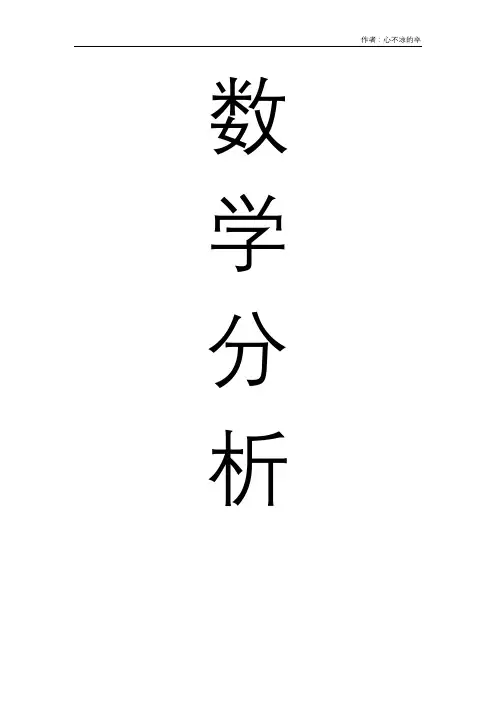
数学分析第一章实数集与函数§1.实数一、 实数及其性质1. 实数的定义:实数,是有理数和无理数的总称。
2. 实数的六大性质:①(四则运算封闭性):实数集R 对加、减、乘、除(除数不为0)四则运算封闭,即任意两个实数的和、差、积、商(除数不为0)仍然是实数。
②(有序性):实数集是有序的,即任意两个实数a, b 必满足以下三种关系之一:a<b 、a=b 、a>b 。
③(传递性):实数的大小关系具有传递性,即若a>b, b>c 则a>c 。
④(阿基米德性):实数具有阿基米德性,即对任何a, b ∈R, 若b>a>0,则存在正整数na>b.⑤(稠密性):实数集R 具有稠密性,即任意两个不相等的实数之间必有另外一个实数,且既有有理数也有无理数。
⑥实数集R 与数轴上点一一对应。
二、 绝对值与不等式1. 实数绝对值的性质: ①0;00a a a a =-≥==当且仅当时有 ②-a a a ≤≤ ③;a h h a h a h h a h <<=>-<<≤<=>-≤≤ ④a b a b a b -≤±≤+三角不等式⑤ab a b = ⑥(0)a a b b b=≠ §2数集·确界原理一、 区间与邻域1. 有限区间:开区间:{}x a x b <<记作(),a b ;闭区间:{}x a x b ≤≤记作[],a b ;半开半闭区间:{}x a x b ≤<记作[),a b ,{}x a x b <≤记作(],a b无限区间:(]{},a x a -∞=≤,(){},a x x a -∞=≤,(){},a x x a +∞=>,(){},x x R -∞+∞=-∞<<+∞=2. 邻域:设a R ∈,0>,满足绝对值不等式x a -<的全体实数x 的集合称为点a 的邻域,记作();U a 或写作()U a ,即有(){}();,U a x x a a a =-<=-+。
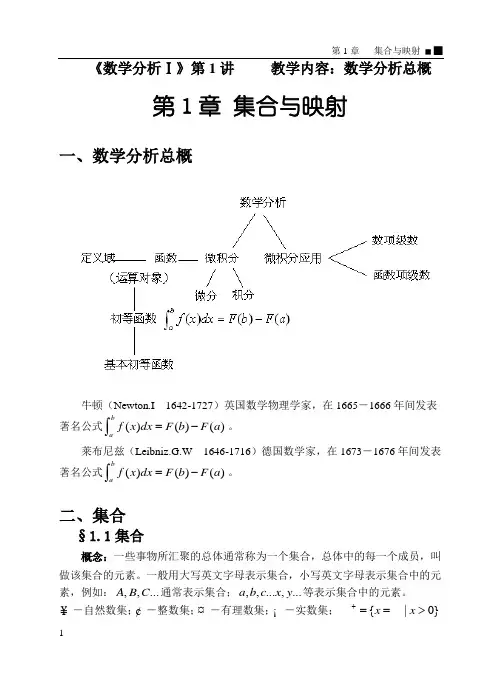
第1章 集合与映射 █ █1《数学分析Ⅰ》第1讲 教学内容:数学分析总概第1章 集合与映射一、数学分析总概牛顿(Newton.I 1642-1727)英国数学物理学家,在1665-1666年间发表著名公式()()()baf x dx F b F a =-⎰。
莱布尼兹(Leibniz.G.W 1646-1716)德国数学家,在1673-1676年间发表著名公式()()()b af x dx F b F a =-⎰。
二、集合 §1.1集合概念:一些事物所汇聚的总体通常称为一个集合,总体中的每一个成员,叫做该集合的元素。
一般用大写英文字母表示集合,小写英文字母表示集合中的元素,例如:,,...A B C 通常表示集合;,,...,...a b c x y 等表示集合中的元素。
-自然数集; -整数集; -有理数集; -实数集; {|0}x x +==>▇ ▇ 数学分析2有限集 可列集 无限极 空集 子集 ∙集合的运算:(1)并集:A B{|A B x x A =∈ 或}x B ∈见(图1-1)(2)交集:A B{|A B x x A =∈ 且}x B ∈见(图1-2)(3)差集:A B -{|A B x x A -=∈且}x B ∉见(图1-3)(4)设 A X ⊂,即A 为X 的子集,补集:CA X A =-称为A 的补集。
见(图1-4)(5)无限并:设12,,...,...n A A A 是一 列集合,定义1{|,}nn n x n x A ∞=A=∃∈∈(6)无限交:设12,,...,...n A A A 是一 列集合,定义1{|,}nn n Ax n x A ∞==∀∈∈设Γ是任意的一个非空集合(拓扑集),α∀∈Γ,对应有集合A α, {:}A αα∈Γ称为集合族,无论Γ是有限集、可列集、还是不可列集(不可数集),都可定义(1) 不可数并:{|,}A x x A αααα∈Γ=∃∈Γ∈ (2) 不可数交:{|,}A x x A αααα∈Γ=∀∈Γ∈第1章 集合与映射 █ █3命题1.1 设{ A α:α∈Γ}中每一个集合都是某个大集合X 的子集,记 A C=X -A ,其中A ⊂X ,则 (3) ()c αα∈ΓA =c αα∈ΓA (4)()c αα∈ΓA =c αα∈ΓA 上面公式(9)和(10)通常称为DeMorgan 公式(隶末根定理)。
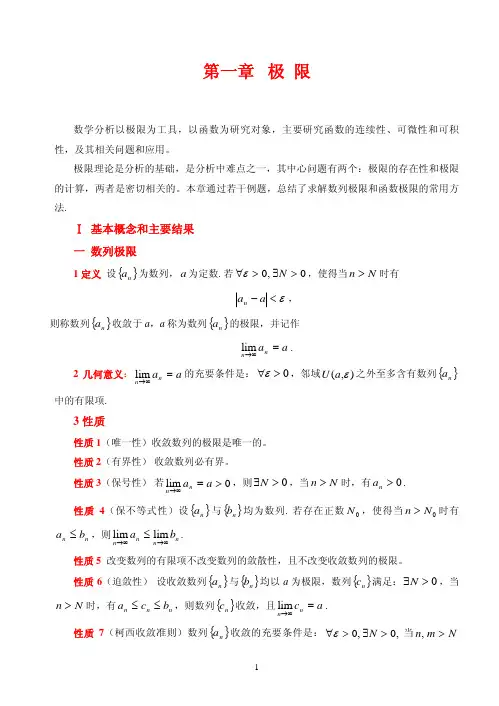
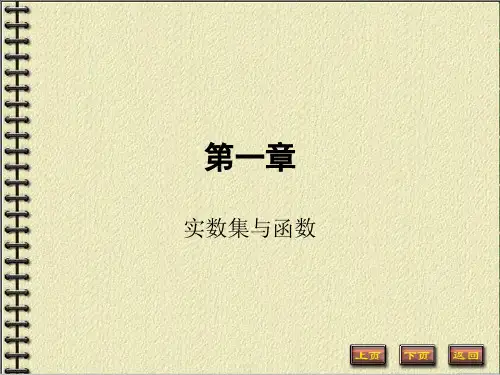
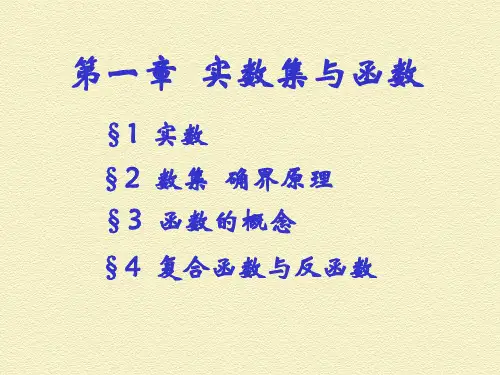

数分上册知识点总结数学分析是研究函数的连续性、可导性和积分性质的一门数学分支,是数学系基础课程之一。
通过学习数学分析,可以帮助学生建立完整的数学理论体系,提高数学思维能力和分析问题的能力。
下面是数学分析上册的知识点总结。
第一章实数系1.实数的引入实数是一个含有无数元素的集合,包括整数、有理数和无理数。
实数集的代数结构是一个域,具有加法和乘法两种运算,满足交换律、结合律和分配律等性质。
2.集合的基本性质集合的基本概念包括子集、空集、全集、交集和并集等。
集合的运算包括并集、交集和差集等。
3.实数的基本性质实数的基本性质包括实数的大小关系、实数的绝对值、实数的加法和乘法性质等。
4.单调有界数列的极限单调有界数列的极限存在且为实数。
单调有界数列极限存在的原因是实数的完备性。
第二章实函数的极限1.实数集上的一个动点集合实数集上的动点集合包括收敛点列、数列的上极限和下极限等。
2.函数的定义域和值域函数的定义域和值域是函数的基本概念。
函数的定义域是所有自变量可能取值的实数集合,值域是所有因变量可能取值的实数集合。
3.极限实数系上的函数的极限是该函数在某一点取值无限接近于一个确定的数。
最典型的场景是自变量趋近于某一点时因变量的值接近于一个确定的数。
4.无穷小与无穷大无穷小和无穷大是极限的概念,无穷小是函数在某一点为零,无穷大是函数在某一点为无穷大。
第三章连续函数1.连续函数和间断点连续函数的定义是对于任何一点,只要自变量足够接近,函数值也接近于该点的函数。
间断点是函数在某一点处不连续的点。
2.连续函数的性质连续函数有保号性、介值性、零点定理等性质,加减乘除连续函数仍然是连续函数。
3.基本初等函数的连续性常见的初等函数包括多项式函数、指数函数、对数函数、三角函数和反三角函数。
这些函数在其定义域内是连续的。
第四章导数与微分1.导数的概念导数是函数在一点处的变化率,也是导函数。
函数在一点处可导的条件是函数在该点连续且有左右导数,并且左右导数相等。
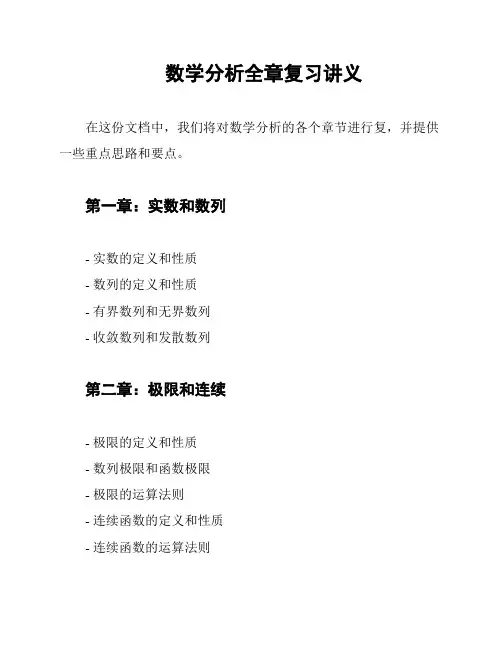
数学分析全章复习讲义
在这份文档中,我们将对数学分析的各个章节进行复,并提供一些重点思路和要点。
第一章:实数和数列
- 实数的定义和性质
- 数列的定义和性质
- 有界数列和无界数列
- 收敛数列和发散数列
第二章:极限和连续
- 极限的定义和性质
- 数列极限和函数极限
- 极限的运算法则
- 连续函数的定义和性质
- 连续函数的运算法则
第三章:导数和微分
- 函数的导数定义和性质
- 导数与连续性的关系
- 一阶导数和高阶导数
- 微分的定义和性质
- 微分中值定理和泰勒公式
第四章:积分
- 不定积分和定积分的定义和性质
- 积分中值定理和牛顿-莱布尼茨公式- 反常积分的概念和判定
- 定积分的计算方法
第五章:级数
- 级数的定义和性质
- 收敛级数和发散级数的判定方法
- 常见级数的求和
- 幂级数和泰勒级数
第六章:函数序列和一致连续性
- 函数序列的极限和一致收敛
- 一致连续性的定义和性质
第七章:多元函数的极限和连续
- 多元函数的极限定义和性质
- 多元函数的连续性定义和性质
- 偏导数和全微分的概念
第八章:多元函数的导数和微分
- 多元函数的偏导数和混合偏导数
- 多元函数的全微分和复合函数的导数
- 隐函数的导数和参数方程的导数
以上是数学分析的全章复习内容,希望对你的学习有所帮助!。
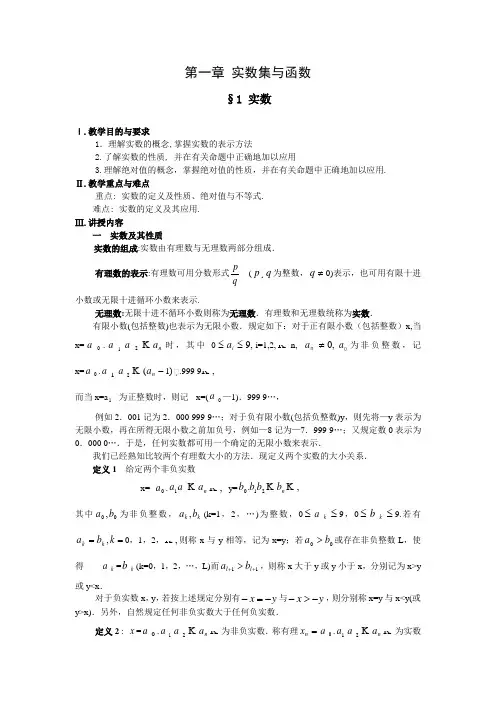
第一章 实数集与函数§1 实数Ⅰ.教学目的与要求1.理解实数的概念,掌握实数的表示方法2.了解实数的性质, 并在有关命题中正确地加以应用3.理解绝对值的概念,掌握绝对值的性质,并在有关命题中正确地加以应用. Ⅱ.教学重点与难点重点: 实数的定义及性质、绝对值与不等式.难点: 实数的定义及其应用.Ⅲ.讲授内容一 实数及其性质实数的组成:实数由有理数与无理数两部分组成.有理数的表示:有理数可用分数形式q p(p ˛q 为整数,q ≠0)表示,也可用有限十进小数或无限十进循环小数来表示.无理数:无限十进不循环小数则称为无理数.有理数和无理数统称为实数.有限小数(包括整数)也表示为无限小数.规定如下:对于正有限小数(包括整数)x,当x=a 0.a1a 2n a K 时,其中0,9≤≤i a i=1,2,K n, na ,0≠0a 为非负整数,记x=a 0.a 1a 2-n a (K 1)̣.999 9,K而当x=a 1为正整数时,则记x=(a 0—1).999 9…,例如2.001记为2.000 999 9…;对于负有限小数(包括负整数)y ,则先将—y 表示为无限小数,再在所得无限小数之前加负号,例如—8记为—7.999 9…;又规定数0表示为0.000 0….于是,任何实数都可用一个确定的无限小数来表示.我们已经熟知比较两个有理数大小的方法.现定义两个实数的大小关系. 定义1 给定两个非负实数x= 0a .a a 1n a K ,K y=,.210K K n b b b b其中00,b a 为非负整数,k k b a ,(k=1,2,…)为整数,0≤a k ≤9,0≤b k ≤9.若有==k b a k k ,0,1,2,,K 则称x 与y 相等,记为x=y ;若00b a >或存在非负整数L ,使得 a k =b k (k=0,1,2,…,L)而11++>l l b a ,则称x 大于y 或y 小于x ,分别记为x>y 或y<x .对于负实数x ,y ,若按上述规定分别有y x -=-与y x ->-,则分别称x=y 与x<y(或y>x).另外,自然规定任何非负实数大于任何负实数.定义2 : x =a 0.a 1a 2n a K K 为非负实数.称有理=n x a 0.1a a 2n a K K 为实数x 的n 位不足近似,而有理数=n x nn x 101+称为x 的n 位过剩近似,n=0,1,2,K . 对于负实数ΛΛn a a a a a x 3210.-=,其n 位不足近似与过剩近似分别规定为n n n a a a a a x 101.3210--=Λ与=n x n a a a a a Λ3210.-. 注 不难看出,实数x 的不足近似n x 当n 增大时不减,即有x 0≤x 1≤x 2≤…,而过剩近似n x 当n 增大时不增,即有0x ≥1x ≥2x ≥….命题 设x=a 0.a 1a2K 与y=b 0.b 1b 2…为两个实数,则x>y 的等价条件是:存在非负整数n ,使得 x n >n y ,其中x n 表示x 的n 位不足近似,n y 表示y 的n 位过剩近似.例1 设x 、y 为实数,x<y.证明:存在有理数r 满足x y r <<.证 由于x y <,故存在非负整数n,使得n n y x <,令 r=),(21n n y x + 则r 为有理数,且有 x ,y y r x n n ≤<<≤即得 x<r<y .全体实数构成的集合记为R,即 R =}.|{为实数x x实数的主要性质:1.实数集R 对加、减、乘、除(除数不为0)四则运算是封闭的,即任意两个实数的和、差、积、商(除数不为0)仍然是实数.2.实数集是有序的,即任意两实数a 、b 必须满足下述三个关系之一:a <b, a =b ,a >b .3.实数的大小关系具有传递性,即若a >b ,b >c ,则有a >c .4.实数具有阿基米德(Archimedes)性,即对任何a 、b ∈R ,若b >a >0,则存在正整数n ,使得n a >b .5.实数集R 具有稠密性,即任何两个不相等的实数之间必有另一个实数,且既有有理数(见例1),也有无理数.6.如果在一直线(通常画成水平直线)上确定一点O 作为原点,指定一个方向为正向(通常把指向右方的方向规定为正向),并规定一个单位长度,则称此直线为数轴.任一实数都对应数轴上唯一的一点;反之,数轴上的每一点也都唯一地代表一个实数.于是,实数集R 与数轴上的点有着一一对应关系.因此在以后的叙述中,常把“实数a ”与“数轴上的点a ”看作具有相同的含义﹒例2 设a 、b ∈R .证明:若对任何正数ε有a <b +ε,则a ≤b .证 用反证法.倘若结论不成立,则根据实数集的有序性,有a >b .令a =εb -,则ε为正数且ε+=b a ,但这与假设a <b ε+相矛盾.从而必有a ≤b .二 绝对值与不等式实数a 的绝对值定义为⎩⎨⎧<-≥=.0,,0,a a a a a 从数轴上看,数a 的绝对值a 就是点a 到原点的距离.实数的绝对值有如下一些性质:1. a a -=≥0;当且仅当a =0时有a =0.2.a -≤a ≤a .3.a h <h a h <<-⇔;()0>≤≤-⇔≤h h a h h a ﹒4.对于任何a 、b ∈R 有如下的三角形不等式:b a b a b a +≤±≤-.5.b a ab =.6.()0≠=b ba b a . 下面只证明性质4,其余性质由学生自行证明.由性质2有.,b b b a a a ≤≤-≤≤-两式相加后得到 .)(b a b a b a +≤+≤+-根据性质3,上式等价于.b a b a +≤+ ()1将(1)式b 换成b -,(1)式右边不变,即得b a b a +≤-,这就证明了性质4不等式的右半部分.又由)式有据(1,b b a a +-=.b b a a +-≤从而得.b a b a -≤- ()2 将(2)式中b 换成b -,即得得性质4.b a b a +≤-证.Ⅳ 小结与提问:本节要求学生掌握实数的概念及其性质,牢记并熟练运用实数绝对值的有关性质以及常见的不等式,并在有关命题证明中正确地加以运用.3、4、5、6、7、8、9.Ⅴ课外作业:P4。
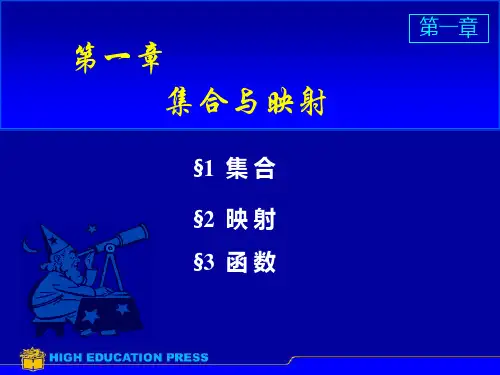
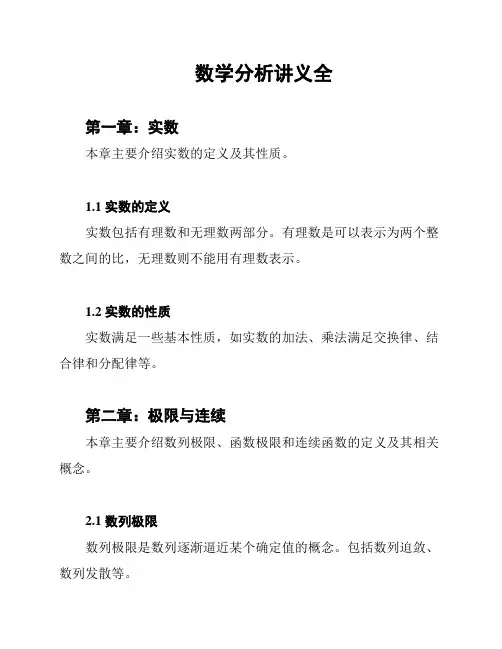
数学分析讲义全第一章:实数本章主要介绍实数的定义及其性质。
1.1 实数的定义实数包括有理数和无理数两部分。
有理数是可以表示为两个整数之间的比,无理数则不能用有理数表示。
1.2 实数的性质实数满足一些基本性质,如实数的加法、乘法满足交换律、结合律和分配律等。
第二章:极限与连续本章主要介绍数列极限、函数极限和连续函数的定义及其相关概念。
2.1 数列极限数列极限是数列逐渐逼近某个确定值的概念。
包括数列迫敛、数列发散等。
2.2 函数极限函数极限是函数在某点逐渐接近某个确定值的概念。
包括左极限、右极限等。
2.3 连续函数连续函数是函数在某点处无间断、无跳跃的性质。
第三章:导数与微分本章主要介绍导数、微分的定义及其相关性质。
3.1 导数的定义导数描述了函数在某一点的变化率。
包括函数的导数定义、导数的性质等。
3.2 微分的定义微分是函数在某点处的线性近似。
包括函数的微分定义、微分的性质等。
第四章:积分与定积分本章主要介绍积分、定积分的定义及其应用。
4.1 积分的定义积分是函数的反导数。
包括不定积分、定积分等。
4.2 定积分的性质定积分具有线性性质、加法性质、区间可加性等。
第五章:级数本章主要介绍级数的概念及其计算方法。
5.1 级数的定义级数是无穷数列之和的概念。
包括级数收敛、级数发散等。
5.2 级数的计算方法级数的计算方法具有求和、判定级数收敛性等。
这份讲义全面介绍了数学分析的基础知识,希望能帮助到您。
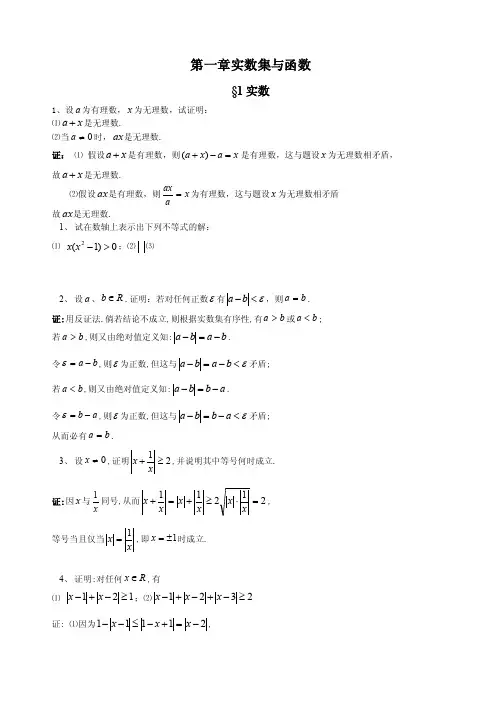
第一章实数集与函数§1实数1、设a 为有理数,x 为无理数,试证明:⑴x a +是无理数.⑵当0≠a 时,ax 是无理数.证: ⑴ 假设x a +是有理数,则x a x a =-+)(是有理数,这与题设x 为无理数相矛盾, 故x a +是无理数.⑵假设ax 是有理数,则x aax=为有理数,这与题设x 为无理数相矛盾 故ax 是无理数.1、 试在数轴上表示出下列不等式的解: ⑴ 0)1(2>-x x ;⑵⑶2、 设a 、R b ∈.证明:若对任何正数ε有ε<-b a ,则b a =. 证:用反证法.倘若结论不成立,则根据实数集有序性,有b a >或b a <; 若b a >,则又由绝对值定义知:b a b a -=-.令b a -=ε,则ε为正数,但这与ε<-=-b a b a 矛盾; 若b a <,则又由绝对值定义知:a b b a -=-.令a b -=ε,则ε为正数,但这与ε<-=-a b b a 矛盾; 从而必有b a =. 3、 设0≠x ,证明21≥+xx ,并说明其中等号何时成立. 证:因x 与x 1同号,从而21211=⋅≥+=+xx x x x x , 等号当且仅当xx 1=,即1±=x 时成立.4、 证明:对任何R x ∈,有⑴ 121≥-+-x x ;⑵2321≥-+-+-x x x 证: ⑴因为21111-=+-≤--x x x ,所以121≥-+-x x .⑵因为21132-+-≤-≤--x x x x , 所以2321≥-+-+-x x x5、 设a 、b 、+∈R c (+R 表示全体正实数的集合),证明:c b c a b a -≤+-+2222证:对任意的正实数a 、b 、c 有)(22222c b a bc a +≤,两端同时加244c b a +,有224222222242c b a c a b a bc a c b a +++≤++, 即))(()(222222c a b a bc a ++≤+bc c a b a a 2))((2222222-≤++-,两端再同加22c b +,则有c b c a b a -≤+-+2222其几何意义为:当c b ≠时,以),(b a ,),(c a ,)0,0(三点为顶点的三角形,其两边之差小于第三边. 当c b =时,此三角形变为以),(c a ,)0,0(为端点的线段,此时等号成立6、 设0,0>>b x ,且b a ≠,证明x b x a ++介于1与ba之间. 证:因为x b a b x b x a +-=++-1,)()(x b b a b x b a x b x a +-=-++,且0,0>>b x 所以当b a >时, b ax b x a <++<1; 当b a <时, 1<++<xb xa b a ; 故x b x a ++总介于1与ba 之间.7、 设p 为正整数,证明:若p 不是完全平方数,则p 是无理数证:假设p 是有理数,则存在正整数m 、n 使nmp =,且m 与n 互素. 于是22m p n =.可见n 能整除2m .由于m 与n 互素,从而它们的最大公因数为1,由辗转相除法知:存在整数u 、v 使1=+nv mu .从而m mnv u m =+2因n 能整除2m ,又能整除mnv ,故能整除其和,于是n 可整除m ,这样1=n 因此2m p =.这与p 不是完全平方数相矛盾, 故p 是无理数8、 设a 与b 为已知实数,试用不等式符号(不用绝对值符号)表示下列不等式的解: ⑴ b x a x -<-;⑵b x a x -<-;⑶b a x <-2.解: ⑴原不等式等价于11<---bx ba 这又等价于20<--<b x b a 即⎩⎨⎧-<-<>b x b a b x 220或⎩⎨⎧->-><b x b a bx 220即⎪⎪⎩⎪⎪⎨⎧>+>>b a b a x b x 2或⎪⎪⎩⎪⎪⎨⎧<+<<ba b a x b x 2故当b a >时,不等式的解为2ba x +>当b a <时,不等式的解为2ba x +<当b a =时,不等式无解.⑵原不等式等价于⎩⎨⎧-<->b x a x b x 且⎩⎨⎧-<->b x x a bx即⎩⎨⎧>>b a b x 且⎪⎩⎪⎨⎧+>>2b a x bx 故当b a >时,21bx +>; 当b a ≤时,不等式无解. ⑶当0≤b 时,显然原不等式无解,当0>b 时原不等式等价于b a x b a +<<-2因此①当0≤+b a 或0≤b 时,无解②当0>+b a 且0>b 时,有解 Ⅰ 如果b a ≥,则解为b a x b a +<<-即b a x b a +<<-或b a x b a +>>--Ⅱ 如果b a <,则解为b a x +< 即b a x b a +<<+-§2数集 确界原理1、 用区间表示下列不等式的解: ⑴01≥--x x ;⑵61≤+xx ; ⑶0))()((>---c x b x a x (a 、b 、c 为常数,且c b a <<)⑷22sin ≥x 解 ⑴原不等式等价于以下不等式组⎩⎨⎧≥--<011x x x 或⎩⎨⎧≥--≥011x x x前一不等式组的解为21≤x ,后一不等式组无解. 所以原不等式的解为⎥⎦⎤ ⎝⎛∞-∈21,x ⑵不等式61≤+xx 等价于616≤+≤-x x这又等价于不等式组⎩⎨⎧≤+≤->x x x x 61602或⎩⎨⎧-≤+≤<xx x x 61602前一不等式组的解为]223,223[+-∈x ,后一不等式组解为]223,223[+---∈x . 因此原不等式解为 ]223,223[]223,223[+-+---∈x⑶令))()(()(c x b x a x x f ---=,则由c b a <<知:⎪⎩⎪⎨⎧∞+∈>-∞∈<= ;),(),(,0;),(),(,0)(c b a x c b a x x f因此0)(>x f 当且仅当 ;),(),(∞+∈c b a x因此原不等式的解为 ),(),(∞+∈c b a x .⑷当]43,4[ππ∈x 时22sin ≥x .由正弦函数的周期性知22sin ≥x 的解是]432,42[ππππ++∈k k x ,其中k 是整数2、设S 为非空数集,试给出下列概念的定义:⑴数集S 没有上界; ⑵数集S 无界.解: ⑴设S 为一非空数集,若对任意的0>M ,总存在S x ∈0,使M x >0,则称数集S 没有上界 ⑵设S 为一非空数集,若对任意的0>M ,总存在S x ∈0,使M x >0,则称数集S 无界3、证明:由(3)式确定的数集有上界,无下界. 证:{}22R x x y y S ∈-==.对任意的R x ∈,222≤-=x y 所以数集S 有上界2而对任意的0>M ,取m x +=31,则S M M x y ∈--=--===1322211, 但M y -<1,因此数集S 无下界4、 求下列数集的上、下确界,并依定义加以验证. ⑴{}22<=x x S⑵{},!为自然数n n x x S ==; ⑶{})1,0(内的无理数为x x S =; ⑷⎩⎨⎧=-==},2,1,211 n x x S n 解: ⑴2sup =S ,2inf -=S ,以下依定义加以验证.由22<x 知22<<-x ,因之对任意的S x ∈,有2<x 且2->x ,即2,2-分别是S 的上、下界.又对任意的0>ε,不妨设22<ε,于是存在220ε-=x ,221ε+-=x使0x 、1x S ∈,但ε->20x ,ε+-<21x ,所以2sup =S ,2inf -=S⑵+∞=S sup ,1inf =S ,以下依定义加以验证. 对任意的S x ∈,+∞<≤x 1,所以1是S 的下界.对任意的自然数n ,+∞<!n ,所以+∞=S sup ;对任意的0>ε,存在S x ∈==1!11,使ε+<11x ,所以1inf =S ⑶1sup =S ,0inf =S ,以下依定义加以验证.对任意的S x ∈,有10<<x ,所以1、0分别是S 的上、下界.又对任意的0>ε,取εη<<0,且使η-1为无理数,则η-1S ∈,εη->-11 所以1sup =S ;由η的取法知η是无理数,S ∈η,εεη+=<0,所以0inf =S⑷1sup =S ,21inf =S ,以下依定义加以验证. 对任意的S x ∈,有121≤≤x ,所以1、21分别是S 的上、下界.对任意的0>ε,必存在自然数k ,使S x k k ∈-=211,且ε->-=1211k k x所以1sup =S又S x ∈=-=21211,ε+<=-=2121211x 所以21inf =S5. 设S 为非空有下界数集.证明:S S S min inf =⇔∈=ξξ证:设S S ∈=inf ξ,则对一切S x ∈有ξ≥x ,而S ∈ξ,故ξ是数集S 中最小的数,即S min =ξ. 设S min =ξ,则S ∈ξ,下面验证S inf =ξ. Ⅰ 对一切S x ∈,有ξ≥x ,即ξ是S 的下界. Ⅱ 对任何ξβ>,只须取S x ∈=ξ0,则β<0x ,从而ξ不是S 的下界,故S inf =ξ.6.设S 为非空数集,定义}{S x x S ∈-=-,证明:⑴S S sup inf -=-⑵S S inf sup -=-证: ⑴设-=S inf ξ,由下确界的定义知,对任意的-∈S x ,有ξ≥x ,且对任意的0>ε,存在-∈S x 0,使εξ+<0x由}{S x x S ∈-=-知, 对任意的S x ∈-,ξ-≤-x ,且存在S x ∈-0,使εξ-->-0x ,由上确界的定义知ξ-=-S sup ,即S S sup inf -=-. 同理可证⑵式成立.7.设B A 、皆为非空有界数集,定义数集},,{B y A x y x z z B A ∈∈+==+. 证明: ⑴B A B A sup sup )sup(+=+ ⑵B A B A inf inf )inf(+=+ 证: ⑴设1sup η=A ,2sup η=B .对任意的B A z +∈,存在A x ∈,B y ∈,使y x z +=. 于是1η≤x ,2η≤y ,从而21ηη+≤z对任意的0>ε,必存在A x ∈0,B y ∈0且210εη->x ,220εη->y ,则存在B A y x z +∈+=000,使εηη-+>)(210z ,所以B A B A sup sup )sup(21+=+=+ηη ⑵同理可证8.设x a a ,1,0≠>为有理数,证明:{{⎪⎩⎪⎨⎧<>=<<,1}inf ,1}sup a r a a r a a rxr r x r x ,当为有理数,当为有理数证: 只证1>a 的情况, 1<a 的情况可以类似地予以证明.设}{x r r a E r<=,为有理数.因为1>a ,r a 严格递增,故对任意的有理数x r <,有x r a a <,即x a 是E 的一个上界.对任意的0>ε,不妨设x a <ε,于是必存在有理数x r <0,使得xr x a a a <<-0ε.事实上,由x a log 递增知:xx a a <-<ε0等价于x a a xa x a =<-log )(log ε取有理数0r ,使得x r a xa <<-0)(log ε.所以E a xsup =,即}{sup 为有理数r aa rxr x<=§4具有某些特征的函数1、证明:21)(x xx f +=是R 上的有界函数. 证: 利用不等式212x x +≤有2112211)(22≤+=+=x x xx x f 对一切的),(∞+-∞∈x 都成立 故21)(x xx f +=是R 上的有界函数2、⑴证明陈述无界函数的定义; ⑵证明:21)(x x f =为)1,0(上的无界函数. ⑶举出函数f 的例子,使f 为闭区间]1,0[上的无界函数.解: ⑴设)(x f 在D 上有定义,若对任意的正数M ,都存在D x ∈0,使M x f >)(0,则称函数)(x f 为D 上的无界函数.⑵对任意的正数M ,存在)1,0(110∈+=M x ,使M M x x f >+==11)(2所以21)(xx f =为)1,0(上的无界函数. ⑶设⎪⎩⎪⎨⎧=∈=0,0]1,0(,1)(x x x x f .下证)(x f 为无界函数0>∀M ,]1,0(110∈+=∃M x ,使得M M x f >+=1)(0 所以⎪⎩⎪⎨⎧=∈=0,0]1,0(,1)(x x x x f 是闭区间[0,1]上的无界函数.3、 证明下列函数在指定区间上的单调性: ⑴13-=x y 在),(∞+-∞内严格递增; ⑵x y sin =在]2,2[ππ-上严格递增;⑶x y cos =在],0[π上严格递减.证: ⑴任取1x 、),(2∞+-∞∈x ,21x x <, 则0)(3)13()13()()(212121<-=---=-x x x x x f x f , 可见)()(21x f x f <,所以13-=x y 在),(∞+-∞内严格递增. ⑵任取1x 、]2,2[2ππ-∈x ,21x x <,则有22221ππ<+<-x x ,02221<-≤-x x π, 因此02cos21>+x x ,02sin 21<-x x , 从而02sin 2cos 2sin sin )()(21212121<-+=-=-x x x x x x x f x f , 故)()(21x f x f <,所以x y sin =在]2,2[ππ-上严格递增.⑶任取1x 、],0[2π∈x ,21x x <,则π<+<2021x x ,02221<-≤-x x π, 从而02sin21>+x x ,02sin 21<-x x 02sin 2sin2cos cos )()(21212121>-+-=-=-x x x x x x x f x f 故)()(21x f x f >,所以x y cos =在],0[π上严格递减.4、 判别下列函数的奇偶性:(1)12)(24-+=x x x f ;(2) x x x f sin )(+=;(3)22)(x e x x f -=; (4))1lg()(2x x x f -+=解(1)因)(121)(2)()(2424x f x x x x x f =-+=--+-=-, 故12)(24-+=x x x f 是偶函数. (2)因),()sin ()sin()()(x f x x x x x f -=+-=-+-=-故x x x f sin )(+=是奇函数.(3)因)()()(222)(2x f e x e x x f x x ==-=----,故22)(x e x x f -=是偶函数. (4))()1lg(11lg)1lg())(1lg()(2222x f x x x x x x x x x f -=++-=++=++-=-++-=-故)1lg()(2x x x f -+=是奇函数.5、 求下列函数的周期:(1)x x f 2cos )(=;(2)x x f 3tan )(=;(3)3sin 22cos )(xx x f +=. 解 (1) )2cos 1(21cos )(2x x x f +==,而x 2cos 1+的周期是π,所以x x f 2cos )(=的周期是π. (2))3tan(x 的周期是3π,所以x x f 3tan )(=的周期是3π. (3)2cos x 的周期是π4,3sin x 的周期是π6,所以3sin 22cos )(xx x f +=的周期是π12.6、 设)(x f 为定义在],[a a -上的任一函数,证明: (1) ],[),()()(a a x x f x f x F -∈-+=为偶函数; (2) ],[),()()(a a x x f x f x G -∈--=为奇函数; (3) f 可表示为某个奇函数与某个偶函数之和.证 (1)由已知函数)(x F 的定义域关于原点对称且],,[a a x -∈∀)()()()()()(x F x f x f x f x f x F =-+=+-=-.故)(x F 为],[a a -的偶函数.(2) 由已知函数)(x G 的定义域关于原点对称且],,[a a x -∈∀有)()]()([)()()(x G x f x f x f x f x G -=---=--=-.故)(x G 为],[a a -的奇函数.(3)由(1)(2)知: ),(2)()(x f x G x F =+从而)(21)(212)()()(x G x F x G x F x f +=+=,而)(x F ,)(x G 分别是偶函数和奇函数.显然)(21x F 也是偶函数, )(21x G 也是奇函数.从而f 可表示为某个奇函数与某个偶函数之和.7、 设)(x f ,)(x g 为定义在D 上的有界函数,且对任一)()(,x g x f D x ≤∈,证明:(1))(sup )(sup x g x f Dx D x ∈∈≤;(2) )(inf )(inf x g x f Dx D x ∈∈≤. 证 (1)假设)(sup )(sup x g x f Dx D x ∈∈>. 令))(sup )(sup (21x g x f D x D x ∈∈-=ε,则0>ε 由上确界定义知,存在D x ∈0,))(sup )(sup (21)(sup )(0x g x f x f x f Dx D x D x ∈∈∈+=->ε,又对任意的D x ∈,<)(x g ))(sup )(sup (21)(sup x g x f x g D x D x D x ∈∈∈+=+ε. 由此知)()(0x g x f >,这与题设)()()(D x x g x f ∈∀≤相矛盾,所以)(sup )(sup x g x f D x D x ∈∈≤.(2)同理可证结论成立.8、 设f 为定义在D 上的有界函数,证明:(1) )(inf )}({sup x f x f Dx D x ∈∈-=-;(2) )(sup )}({inf x f x f Dx D x ∈∈-=- 证: (1)令ξ=∈)(inf x f Dx .由下确界的定义知,对任意的D x ∈,ξ≥)(x f ,即ξ-≤-)(x f , 可见ξ-是)(x f -的一个上界;对任意的0>ε,存在D x ∈0,使εξ+<)(0x f ,即εξ-->-)(0x f ,可见ξ-是)(x f -的上界中最小者.所以)(inf )}({sup x f x f Dx D x ∈∈-=-=-ξ(2)同理可证结论成立.9、 证明:函数x x f tan )(=在)2,2(ππ-内为无界函数,但在)2,2(ππ-内任一闭区间[]b a ,上有界.证: (1)对任意的正数M ,取)1arctan(0+=M x , 则220ππ<<-x ,M M M x >+=+=1)1(tan(arctantan 0 所以x x f tan )(=在)2,2(ππ-内是无界函数. (2)任取[]b a ,)2,2(ππ-∈,由于x tan 在[]b a ,上是严格递增的,从而b x a tan tan tan ≤≤对任意的[]b a x ,∈都成立.令}tan ,tan max{a a M =,则对一切的[]b a x ,∈,有M x ≤tan ,所以x x f tan )(=在)2,2(ππ-内任一闭区间[]b a ,上有界.10、 讨论狄利克雷函数⎩⎨⎧=为无理数时当为有理数时当x x x D ,0,1)(的周期性、单调性、有界性。
第一章函数、极限、连续一、极限1.1数列极限的定义:∀ε>0,存在自然数N,使得当n>N时,就有|x n−a|<ε,那么称数列{x n}收敛于a,记为limn→∞x n=a.称a为此数列的极限;极限不存在的数列称为发散数列.1.2函数极限的定义:设f(x)在a的某个去心领域有定义,A是一个实数。
如果对任一个ε>0,存在一个δ>0,使得当0<|x−a|<δ时,就有|f(x)−A|<ε,那么称f(x)在a处有极限A,记为limx→af(x)=A或f(x)→A(x→a).海涅定理:limx→af(x)=A的充分必要条件是,对任一满足x n→a(∀n,x n≠a)的数列,均有f(x n)→A.定理:limx→af(x)≠A成立的充分必要条件是,存在一个常数ε0>0,使得在a的任何去心邻域,都可以找到一点,满足|f(x)−A|≫ε0.1.3极限的性质及运算定理:如果f(x)在λ处极限存在,则f(x)比在λ的某去心邻域上有界。
定理:函数的极限若存在,则必唯一。
定理:若limx→λf(x)=A,limx→λf(x)=B,且A>B,则存在λ的某个去心邻域N̂λ(δ),使得在N̂λ(δ)上,f(x)>g(x)成立。
(反之,也成立。
)定理(夹逼准则):若f(x)≪ℎ(x)≪g(x)在λ的某个去心邻域上成立,且limx→λf(x)=limx→λg(x)=A,则limx→λℎ(x)=A。
注:(1) limx→af(x)=∞(±∞),函数f(x)为无穷大量;limx→af(x)=0,函数f(x)为无穷小量.(2)若函数极限存在,则函数的极限运算符合四则运算法则。
(3)limx→a f(x)=∞(±∞),则limx→a1f(x)=0;lim x→af (x )=0,limx→a 1f (x )=∞(±∞).(4)若f (x )在λ的某个去心邻域上有界,g (x )当x →λ时为无穷小量,则f(x)g (x )当x →λ时也为无穷小量。
第一章 函 数§1.1 实 数数学分析研究的基本对象是定义在实数集上的函数,为此,我们先简要叙述实数的概念与基本性质。
与基本性质。
一 实数及其性质在中学数学课程中,我们知道实数由有理数和无理数两部分组成。
在中学数学课程中,我们知道实数由有理数和无理数两部分组成。
有理数的特征:全体有理数构成的集合通常记为Q 。
对"q ÎQ (读作任一个有理数q )可以用一个分数表示,即uv q =(u 、v 为整数,且u ¹0),也可以用有限十进小数或无限十进循环小数表示。
如果一个数不能表示成分数,则称为无理数。
有理数和无理数统称为实数。
全体实数构成的集合记为R 。
实数有如下一些主要性质:实数有如下一些主要性质: 1. 实数集关于四则运算是封闭的,即实数集关于四则运算是封闭的,即 "a ,b ÎR ,则a ± b ÎR , a ´ b ÎR ,当b ¹0时,有a ¸b ÎR 。
2. 实数集具有有序性,即"a ,b ÎR ,则以下三个关系式a < b ,a > b ,a = b ,当且仅当只有一个成立。
仅当只有一个成立。
3. 实数的大小关系具有传递性,即"a ,b ,c ÎR ,若a > b ,b > c ,则a > c 。
4. 实数具有阿基米德(Archimedes 287—212 B.C )性,即"a ,b ÎR ,若a > b >0,则$(读作存在)正整数n ,使nb > a 。
5. 实数集R 具有稠密性:"a ,b ÎR ,若a > b ,则$c ÎR 使a >c >b 。
其中c 既可以是有理数,是有理数,也可以是无理数。
也可以是无理数。
Chapter1.Metric Spaces§1.Metric SpacesA metric space is a set X endowed with a metricρ:X×X→[0,∞)that satisfies the following properties for all x,y,and z in X:1.ρ(x,y)=0if and only if x=y,2.ρ(x,y)=ρ(y,x),and3.ρ(x,z)≤ρ(x,y)+ρ(y,z).The third property is called the triangle inequality.We will write(X,ρ)to denote the metric space X endowed with a metricρ.If Y is a subset of X,then the metric space(Y,ρ|Y×Y)is called a subspace of(X,ρ).Example1.Letρ(x,y):=|x−y|for x,y∈I R.Then(I R,ρ)is a metric space.The set I R equipped with this metric is called the real line.Example2.Let I R2:=I R×I R.For x=(x1,x2)∈I R2and y=(y1,y2)∈I R2,defineρ(x,y):=(x1−y1)+(x2−y2).Thenρis a metric on I R2.The set I R2equipped with this metric is called the Euclidean plane.More generally,for k∈I N,the Euclidean k space I R k is the Cartesian product of k copies of I R equipped with the metricρgiven byρ(x,y):=kj=1(x j−y j)21/2,x=(x1,...,x k)and y=(y1,...,y k)∈I R k.Example3.Let X be a nonempty set.For x,y∈X,defineρ(x,y):=1if x=y, 0if x=y.In this case,ρis called the discrete metric on X.Let(X,ρ)be a metric space.For x∈X and r>0,the open ball centered at x∈X with radius r is defined asB r(x):={y∈X:ρ(x,y)<r}.A subset A of X is called an open set if for every x∈A,there exists some r>0 such thatB r(x)⊆A.1Theorem1.1.For a metric space(X,ρ)the following statements are true.1.X and∅are open sets.2.Arbitrary unions of open sets are open sets.3.Finite intersections of open sets are open sets.Proof.Thefirst statement is obviously true.For the second statement,we let(A i)i∈I be a family of open subsets of X and wish to prove that∪i∈I A i is an open set.Suppose x∈∪i∈I A i.Then x∈A ifor some i0∈I.Since A i0is an open set,there exists some r>0such that B r(x)⊆A i.Consequently,B r(x)⊆∪i∈I A i.This shows that∪i∈I A i is an open set.For the third statement,we let{A1,...,A n}be afinite collection of open subsets of X and wish to prove that∩n i=1A i is an open set.Suppose x∈∩n i=1A i.Then x∈A i for every i∈{1,...,n}.For each i∈{1,...,n},there exists r i>0such that B ri(x)⊆A i. Set r:=min{r1,...,r n}.Then r>0and B r(x)⊆∩n i=1A i.This shows that∩n i=1A i is an open set.Let(X,ρ)be a metric space.A subset B of X is called an closed set if its complement B c:=X\B is an open set.The following theorem is an immediate consequence of Theorem1.1.Theorem1.2.For a metric space(X,ρ)the following statements are true.1.X and∅are closed sets.2.Arbitrary intersections of closed sets are closed sets.3.Finite unions of closed sets are closed sets.Let(X,ρ)be a metric space.Given a subset A of X and a point x in X,there are three possibilities:1.There exists some r>0such that B r(x)⊆A.In this case,x is called an interiorpoint of A.2.For any r>0,B r(x)intersects both A and A c.In this case,x is called a boundarypoint of A.3.There exists some r>0such that B r(x)⊆A c.In this case,x is called an exteriorpoint of A.For example,if A is a subset of the real line I R bounded above,then sup A is a boundary point of A.Also,if A is bounded below,then inf A is a boundary point of A.A point x is called a closure point of A if x is either an interior point or a boundary point of A.We denote by A the set of closure points of A.Then A⊆A.The set A is called the closure of A.2Theorem1.3.If A is a subset of a metric space(X,ρ),then A is the smallest closed set that includes A.Proof.Let A be a subset of a metric space.Wefirst show that A is closed.Suppose x/∈A. Then x is an exterior point of A;hence there exists some r>0such that B r(x)⊆A c.If y∈B r(x),thenρ(x,y)<r.Forδ:=r−ρ(x,y)>0,by the triangle inequality we have Bδ(y)⊆B r(x).It follows that Bδ(y)⊆A c.This shows y/∈A.Consequently,B r(x)⊆A c. Therefore,A c is open.In other words,A is closed.Now assume that B is a closed subset of X such that A⊆B.Let x∈B c.Then there exists r>0such that B r(x)⊆B c⊆A c.This shows x∈A c.Hence,B c⊆A c.It follows that A⊆B.Therefore,A is the smallest closed set that includes A.A subset A of a metric space(X,ρ)is said to be dense in X if A=X.§pletenessLet(x n)n=1,2,...be a sequence of elements in a metric space(X,ρ).We say that (x n)n=1,2,...converges to x in X and write lim n→∞x n=x,ifρ(x n,x)=0.limn→∞From the triangle inequality it follows that a sequence in a metric space has at most one limit.Theorem2.1.Let A be a subset of a metric space(X,ρ).Then a point x∈X belongs to A if and only if there exists a sequence(x n)n=1,2,...in A such that lim n→∞x n=x. Proof.If x∈A,then B1/n(x)∩A=∅for every n∈I N.Choose x n∈B1/n(x)∩A for each n∈I N.Thenρ(x n,x)<1/n,and hence lim n→∞x n=x.Suppose x/∈A.Then there exists some r>0such that B r(x)∩A=∅.Consequently, for any sequence(x n)n=1,2,...in A,we haveρ(x n,x)≥r for all n∈I N.Thus,there is no sequence of elements in A that converges to x.A sequence(x n)n=1,2,...in a metric space(X,ρ)is said to be a Cauchy sequence if for any givenε>0there exists a positive integer N such thatm,n>N impliesρ(x m,x n)<ε.Clearly,every convergent sequence is a Cauchy sequence.If a metric space has the property that every Cauchy sequence converges,then the metric space is said to be complete.For example,the real line is a complete metric space.3The diameter of a set A is defined byd(A):=sup{ρ(x,y):x,y∈A}.If d(A)<∞,then A is called a bounded set.Theorem2.2.Let(X,ρ)be a complete metric space.Suppose that(A n)n=1,2,...is a sequence of closed and nonempty subsets of X such that A n+1⊆A n for every n∈I N and lim n→∞d(A n)=0.Then∩∞n=1A n consists of precisely one element.Proof.If x,y∈∩∞n=1A n,then x,y∈A n for every n∈I N.Hence,ρ(x,y)≤d(A n)for all n∈I N.Since lim n→∞ρ(A n)=0,it follows thatρ(x,y)=0,i.e.,x=y.To show∩∞n=1A n=∅,we proceed as follows.Choose x n∈A n for each n∈I N.Since A m⊆A n for m≥n,we haveρ(x m,x n)≤d(A n)for m≥n.This in connection with the assumption lim n→∞d(A n)=0shows that(x n)n=1,2,...is a Cauchy sequence.Since (X,ρ)is complete,there exists x∈X such that lim n→∞x n=x.We have x m∈A n for all=A n.This is true for all n∈I N.Therefore,x∈∩∞n=1A n.m≥n.Hence,x∈A§pactnessLet(X,ρ)be a metric space.A subset A of X is said to be sequentially compact if every sequence in A has a subsequence that converges to a point in A.For example,afinite subset of a metric space is sequentially compact.The real line I R is not sequentially compact.But a bounded closed interval in the real line is sequentially compact.A subset A of a metric space is called totally bounded if,for every r>0,A can be covered byfinitely many open balls of radius r.For example,a bounded subset of the real line is totally bounded.On the other hand, ifρis the discrete metric on an infinite set X,then X is bounded but not totally bounded. Theorem3.1.Let A be a subset of a metric space(X,ρ).Then A is sequentially compact if and only if A is complete and totally bounded.Proof.Suppose that A is sequentially compact.Wefirst show that A is complete.Let (x n)n=1,2,...be a Cauchy sequence in A.Since A is sequentially compact,there exists a )k=1,2,...that converges to a point x in A.For anyε>0,there exists subsequence(x nka positive integer N such thatρ(x m,x n)<ε/2whenever m,n>N.Moreover,there exists some k∈I N such that n k>N andρ(x n,x)<ε/2.Thus,for n>N we havek4ρ(x n,x)≤ρ(x n,x nk )+ρ(x nk,x)<ε.Hence,lim n→∞x n=x.This shows that A iscomplete.Next,if A is not totally bounded,then there exists some r>0such that A cannot be covered byfinitely many open balls of radius r.Choose x1∈A.Suppose x1,...,x n∈A have been chosen.Let x n+1be a point in the nonempty set A\∪n i=1B r(x i).If m,n∈I N and m=n,thenρ(x m,x n)≥r.Therefore,the sequence(x n)n=1,2,...has no convergent subsequence.Thus,if A is sequentially compact,then A is totally bounded.Conversely,suppose that A is complete and totally bounded.Let(x n)n=1,2,...be a sequence of points in A.We shall construct a subsequence of(x n)n=1,2,...that is a Cauchy sequence,so that the subsequence converges to a point in A,by the completeness of A.For this purpose,we construct open balls B k of radius1/k and corresponding infinite subsets I k of I N for k∈I N recursively.Since A is totally bounded,A can be covered byfinitely many balls of radius1.Hence,we can choose a ball B1of radius1such that the set I1:={n∈I N:x n∈B1}is infinite.Suppose that a ball B k of radius1/k and an infinite subset I k of I N have been constructed.Since A is totally bounded,A can be covered by finitely many balls of radius1/(k+1).Hence,we can choose a ball B k+1of radius1/(k+1) such that the set I k+1:={n∈I k:x n∈B k+1}is infinite.Choose n1∈I1.Given n k,choose n k+1∈I k+1such that n k+1>n k.By our construction,I k+1⊆I k for all k∈I N.Therefore,for all i,j≥k,the points x niandx nj are contained in the ball B k of radius1/k.It follows that(x nk)k=1,2,...is a Cauchysequence,as desired.Theorem3.2.A subset of a Euclidean space is sequentially compact if and only if it is closed and bounded.Proof.Let A be a subset of I R k.If A is sequentially compact,then A is totally bounded and complete.In particular,A is bounded.Moreover,as a complete subset of I R k,A is closed.Conversely,suppose A is bounded and closed in I R k.Since I R k is complete and A is closed,A is complete.It is easily seen that a bounded subset of I R k is totally bounded.Let(A i)i∈I be a family of subsets of X.We say that(A i)i∈I is a cover of a subset A of X,if A⊆∪i∈I A i.If a subfamily of(A i)i∈I also covers A,then it is called a subcover. If,in addition,(X,ρ)is a metric space and each A i is an open set,then(A i)i∈I is said to be an open cover.Let(G i)i∈I be an open cover of A.A real numberδ>0is called a Lebesgue number for the cover(G i)i∈I if,for each subset E of A having diameter less thanδ,E⊆G i for5some i∈I.Theorem3.3.Let A be a subset of a metric space(X,ρ).If A is sequentially compact, then there exists a Lebesgue numberδ>0for any open cover of A.Proof.Let(G i)i∈I be an open cover of A.Suppose that there is no Lebesgue number for the cover(G i)i∈I.Then for each n∈I N there exists a subset E n of A having diameter less than1/n such that E n∩G c i=∅for all i∈I.Choose x n∈E n for n∈I N.Since A is sequentially compact,there exists a subsequence(x nk)k=1,2,...which converges to a point x in A.Since(G i)i∈I is a cover of A,x∈G i for some i∈I.But G i is an open set.Hence, there exists some r>0such that B r(x)⊆G i.We canfind a positive integer k such that1/n k<r/2andρ(x nk ,x)<r/2.Let y be a point in E nk.Since x nkalso lies in the setE nk with diameter less than1/n k,we haveρ(x nk,y)<1/n k.Consequently,ρ(x,y)≤ρ(x,x nk)+ρ(x nk,y)<r2+1n k<r.This shows E nk ⊆B r(x)⊆G i.However,E nkwas so chosen that E nk∩G c i=∅.Thiscontradiction proves the existence of a Lebesgue number for the open cover(Gi)i∈I.A subset A of(X,ρ)is said to be compact if each open cover of A possesses afinite subcover of A.If X itself is compact,then(X,ρ)is called a compact metric space. Theorem3.4.Let A be a subset of a metric space(X,ρ).Then A is compact if and only if it is sequentially compact.Proof.If A is not sequentially compact,then A is an infinite set.Moreover,there exists a sequence(x n)n=1,2,...in A having no convergent subsequence.Consequently,for each x∈A,there exists an open ball B x centered at x such that{n∈I N:x n∈B x}is afinite set.Then(B x)x∈A is an open cover of A which does not possess afinite subcover of A. Thus,A is not compact.Now suppose A is sequentially compact.Let(G i)i∈I be an open cover of A.By Theorem3.3,there exists a Lebesgue numberδ>0for the open cover(G i)i∈I.By Theorem 3.1,A is totally bounded.Hence,A is covered by afinite collection{B1,...,B m}of open balls with radius less thanδ/2.For each k∈{1,...,m},the diameter of B k is less thanδ.Hence,B k⊆G ik for some i k∈I.Thus,{G ik:k=1,...,m}is afinite subcover of A.This shows that A is compact.6§4.Continuous FunctionsLet(X,ρ)and(Y,τ)be two metric spaces.A function f from X to Y is said to be continuous at a point a∈X if for everyε>0there existsδ>0(depending onε)such thatτ(f(x),f(a))<εwheneverρ(x,a)<δ.The function f is said to be continuous on X if f is continuous at every point of X.Theorem4.1.For a function f from a metric space(X,ρ)to a metric space(Y,τ),the following statements are equivalent:1.f is continuous on X.2.f−1(G)is an open subset of X whenever G is an open subset of Y.3.If lim n→∞x n=x holds in X,then lim n→∞f(x n)=f(x)holds in Y.4.f(A)⊆f(A)holds for every subset A of X.5.f−1(F)is a closed subset of X whenever F is a closed subset of Y.Proof.1⇒2:Let G be an open subset of Y and a∈f−1(G).Since f(a)∈G and G is open,there exists someε>0such that Bε(f(a))⊆G.By the continuity of f,there exists someδ>0such thatτ(f(x),f(a))<εwheneverρ(x,a)<δ.This shows Bδ(a)⊆f−1(G). Therefore,f−1(G)is an open set.2⇒3:Assume lim n→∞x n=x in X.Forε>0,let V:=Bε(f(x)).In light of statement2,f−1(V)is an open subset of X.Since x∈f−1(V),there exists someδ>0 such that Bδ(x)⊆f−1(V).Then there exists a positive integer N such that x n∈Bδ(x) for all n>N.It follows that f(x n)∈V=Bε(f(x))for all n>N.Consequently, lim n→∞f(x n)=f(x).3⇒4:Let A be a subset of X.If y∈f(A),then there exists x∈A such that y=f(x).Since x∈A,there exists a sequence(x n)n=1,2,...of A such that lim n→∞x n=x. By statement3we have lim n→∞f(x n)=f(x).It follows that y=f(x)∈f(A).This shows f(A)⊆f(A).4⇒5:Let F be a closed subset of Y,and let A:=f−1(F).By statement4we have f(A)⊆⊆F=F.It follows that A⊆f−1(F)=A.Hence,A is a closed subset of X.5⇒1:Let a∈X andε>0.Consider the closed set F:=Y\Bε(f(a)).By statement5,f−1(F)is a closed subset of X.Since a/∈f−1(F),there exists someδ>0 such that Bδ(a)⊆X\f−1(F).Consequently,ρ(x,a)<δimpliesτ(f(x),f(a))<ε.So f is continuous at a.This is true for every point a in X.Hence,f is continuous on X.As an application of Theorem4.1,we prove the Intermediate Value Theorem for continuous functions.7Theorem 4.2.Suppose that a,b ∈I R and a <b .If f is a continuous function from [a,b ]to I R ,then f has the intermediate value property,that is,for any real number d between f (a )and f (b ),there exists c ∈[a,b ]such that f (c )=d .Proof.Without loss of any generality,we may assume that f (a )<d <f (b ).Since the interval (−∞,d ]is a closed set,the set F :=f −1((−∞,d ])={x ∈[a,b ]:f (x )≤d }is closed,by Theorem 4.1.Let c :=sup F .Then c lies in F and hence f (c )≤d .It follows that a ≤c <b .We claim f (c )=d .Indeed,if f (c )<d ,then by the continuity of f we could find r >0such that c <c +r <b and f (c +r )<d .Thus,we would have c +r ∈F and c +r >sup F .This contradiction shows f (c )=d .The following theorem shows that a continuous function maps compact sets to compact sets.Theorem 4.3.Let f be a continuous function from a metric space (X,ρ)to a metric space (Y,τ).If A is a compact subset of X ,then f (A )is compact.Proof.Suppose that (G i )i ∈I is an open cover of f (A ).Since f is continuous,f −1(G i )is open for every i ∈I ,by Theorem 4.1.Hence,(f −1(G i ))i ∈I is an open cover of A .By thecompactness of A ,there exists a finite subset {i 1,...,i m }of I such that A ⊆∪m k =1f−1(G i k ).Consequently,f (A )⊆∪mk =1G i k .This shows that f (A )is compact.Theorem 4.4.Let A be a nonempty compact subset of a metric space (X,ρ).If f is a continuous function from A to the real line I R ,then f is bounded and assumes its maximum and minimum.Proof.By Theorem 4.3,f (A )is a compact set,and so it is bounded and closed.Let t :=inf f (A ).Then t ∈f (A )=f (A ).Hence,t =min f (A )and t =f (a )for some a ∈A .Similarly,Let s :=sup f (A ).Then s ∈f (A )=f (A ).Hence,s =max f (A )and s =f (b )for some b ∈A .A function f from a metric space (X,ρ)to a metric space (Y,τ)is said to be uni-formly continuous on X if for every ε>0there exists δ>0(depending on ε)such that τ(f (x ),f (y ))<εwhenever ρ(x,y )<δ.Clearly,a uniformly continuous function is continuous.A function from (X,ρ)to (Y,τ)is said to be a Lipschitz function if there exists a constant C f such that τ(f (x ),f (y ))≤C f ρ(x,y )for all x,y ∈X .Clearly,a Lipschitz function is uniformly continuous.8Example.Let f and g be the functions from the interval(0,1]to the real line I R given by f(x)=x2and g(x)=1/x,x∈(0,1],respectively.Then f is uniformly continuous, while g is continuous but not uniformly continuous.Theorem4.5.Let f be a continuous function from a metric space(X,ρ)to a metric space(Y,τ).If X is compact,then f is uniformly continuous on X.Proof.Letε>0be given.Since f is continuous,for each x∈X there exists r x>0suchthatτ(f(x),f(y))<ε/2for all y∈B rx (x).Then(B rx(x))x∈X is an open cover of X.Since X is compact,Theorem3.3tells us that there exists a Lebesgue numberδ>0for this open cover.Suppose y,z∈X andρ(y,z)<δ.Then{y,z}⊆B rx(x)for some x∈X. Consequently,τ(f(y),f(z))≤τ(f(y),f(x))+τ(f(x),f(z))<ε/2+ε/2=ε.This shows that f is uniformly continuous on X.9。